|
Wildlife vet work is often a feast or famine phenomenon in this country. It is certainly not suited to those who need routine in their lives, or those who value as little stress as possible. It also involves thousands of back-breaking miles on Zimbabwean roads, or in the air, to get to your patients. The work was coming thick and fast in February 2014 in the run up to our acquaintance of a very special little soul. It started at daybreak on Monday 3rd, with an emergency 300km helicopter trip to Kyle to treat injured rhino Kapfupi (reported on in the April newsletter). In order to keep costs down, and as the helicopter had further work to do in the area the following week, the return journey was done in the AWARE ground team’s vehicle. On the treacherous Chivhu-Harare stretch of road a dog ran out in front of the car and as we slammed on the brakes to avoid the dog, a vehicle crashed straight into the back of us. Fortunately nobody was injured. After an extra 70km out of our way and several hours to pick up the nearest police willing to take the accident report, the disheartened team made it back home in the dark.
On the Thursday we were on another 300km road trip to Gweru. Between Thursday and Friday lunchtime 14 lions were immobilised, and samples taken and processed for routine disease surveillance, following which we drove 600 odd kilometres to Vic Falls on Friday afternoon. Frequent travellers on Zimbabwe’s roads know that such road trips are inevitably punctuated by frequent toll stops and police road blocks. Unbeknownst to us our back brake light had stopped working, which garnered us a rather irritating $20 fine. On Saturday morning two leonine patients were immobilised for a thorough diagnostic evaluation, including digital radiographs which were emailed to German orthopaedic specialists for a valuable second opinion. After a quick bite for lunch, Micky the lion was vasectomised in his muddy pen, as reported in our April newsletter. In the meantime Kariba Animal Welfare Trust was on the phone, potentially needing our assistance to dart a pride of lions that was reportedly moving through the area. They had set cage traps that were rather successful at capturing the local stray dog population, but were not very inviting to the nomadic lions. They, and we, wanted to prevent the unnecessary shooting of these lions as ‘problem animals’ (as happened the previous year) at all costs. We also knew we had a narrow window in which to help (and get our tail light fixed), as we were due to go on our Buhera dog sterilisation campaign the following week (as reported in our March newsletter). So during the 900km drive home on Monday we were mentally preparing to pack our bags for the 400km trip to Kariba the following day. An exasperating argument at a police road block over a second fine for the same rear light malfunction did not improve our moods!
We pulled into Harare at dusk, and collected our dogs from their ‘second home’ with their grandmother. As we sank our tension-wracked bodies onto our couch back home, the landline rang. “Keith, there’s a baby elephant......” It was Roxy Danckwerts, owner of Wild is Life wildlife sanctuary. She proceeded to report that a lone baby elephant had been seen in the afternoon in the shallow water of Musango Island on Lake Kariba. Our hearts sank. It is notoriously difficult to keep an orphaned baby elephant alive. She Whats App’d a blurry mobile phone video of the lone calf that someone at Musango Lodge had managed to take. He looked tiny. He looked lost. We discussed the possibilities of helping this little creature at length with Rox. We knew she was fully prepared to house and nurse the baby, having spent months researching the subject of raising an orphaned elephant in case of this eventuality. Still, it was a huge responsibility, a huge expense and above all, a long shot. Would Parks even grant permission to uplift the little calf?
As I lay in bed that night, I found it hard to switch off my mind. Why had his herd left him? – was there something wrong with him? Had his mother been shot? Had he been washed away in a flooded river? Half of me wondered if it wouldn’t be kinder if the calf was eaten by lions in the night. How long could he survive the dehydration of being separated from his mother?
By morning, when the brave little infant was reported to have survived the night, but was still very much alone in the world, no sign of an elephant herd anywhere, our reservations evaporated and we committed to attempt a rescue. (Fortunately the KAWT pride of lions seemed to have moved away from Kariba, and they no longer needed our help). Roxy spent the morning scurrying around for the necessary permissions and a suitable aircraft, which she found courtesy of Guthrie Air. Keith and I discussed what drugs the baby might need. Would he fight being captured? He could easily cause havoc – possibly even the plane to crash - if he became rambunctious in the light aircraft. He would almost certainly need to be anaesthetised for everybody’s safety. Trouble is, the drug used to immobilise elephants is so powerful that if you draw some into a syringe, then eject the contents back into the bottle, what’s left in the needle is probably enough to knock down a calf (this amount can also kill a person!). On a calf so young keeping it under for an hour and a half’s flight would be risky, but perhaps the lesser of two evils.
 By midday the rescue team comprising Keith, Jos Danckwerts and pilot Kevin convened at Charles Prince airport. There was a sense of urgency to get to Bumi Hills and back by nightfall. Inclement weather was setting in, and the calf’s chances of survival were fading with every hour. The aircraft was reassuringly bigger than we had imagined, a converted 7 seater Piper Navaho, but it still proved to be a bumpy ride as the pilot picked his way around threatening cumulonimbus clouds that had built up over the Zambezi Valley escarpment. Safely down on the bush runway at Bumi, the team was told that the baby ele was ‘on the way’ from Musango. Getting out of the aircraft, Keith felt like he was stepping into a sauna. The three guys sought the shade of the aeroplane wing to keep themselves and the veterinary drugs as cool as they could. Fortunately for the team, the KAWT had contacted Bumi Hills and asked them to provide refreshments, which were gratefully wolfed down. Forty five minutes later the rumble of a land-rover could be heard. As the dark green game-viewing vehicle came into sight, with five men sitting on the back seat rows, there was no elephant to be seen. What’s happened now? As it drew closer, the team realised the baby elephant was, in fact, standing quite calmly beneath the knees of the men on the second row of seats. By midday the rescue team comprising Keith, Jos Danckwerts and pilot Kevin convened at Charles Prince airport. There was a sense of urgency to get to Bumi Hills and back by nightfall. Inclement weather was setting in, and the calf’s chances of survival were fading with every hour. The aircraft was reassuringly bigger than we had imagined, a converted 7 seater Piper Navaho, but it still proved to be a bumpy ride as the pilot picked his way around threatening cumulonimbus clouds that had built up over the Zambezi Valley escarpment. Safely down on the bush runway at Bumi, the team was told that the baby ele was ‘on the way’ from Musango. Getting out of the aircraft, Keith felt like he was stepping into a sauna. The three guys sought the shade of the aeroplane wing to keep themselves and the veterinary drugs as cool as they could. Fortunately for the team, the KAWT had contacted Bumi Hills and asked them to provide refreshments, which were gratefully wolfed down. Forty five minutes later the rumble of a land-rover could be heard. As the dark green game-viewing vehicle came into sight, with five men sitting on the back seat rows, there was no elephant to be seen. What’s happened now? As it drew closer, the team realised the baby elephant was, in fact, standing quite calmly beneath the knees of the men on the second row of seats.
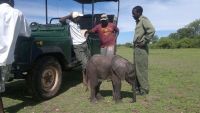 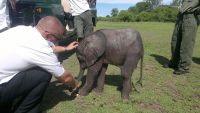 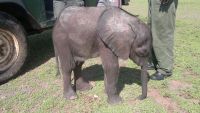
As Keith clapped eyes on the little mite, he cursed to himself. “He’s TINY.” As the creature was offloaded from the truck and stood trying to maintain his balance, Keith instantly knew that any strong drugs would finish the baby off. “He’s buggered”. An intravenous drip was quickly placed into the elephant’s ear vein to start correcting the dehydration. He was so depressed, he barely noticed the needle prick and calmly accepted the life giving fluids. His face and ears seemed to be covered in little red skin lesions. Sunburn? A herpes virus, perhaps?
  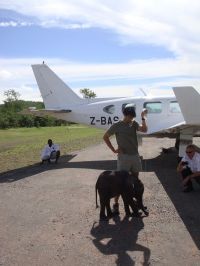
Final permission to take off with the youngster hadn’t yet been granted. The team continued to wait in the sweltering heat while the fluids ran in. Finally, at 1530hrs the team got the green light to lift off. Keith administered a very light sedative to the baby to take any anxiety away, then he was bundled into the body of the aircraft, and persuaded to lie down. He was kept from standing during the flight with a blindfold, and a strategically placed leg draped across his body. He was also escorted by a National Parks ranger for good measure.
 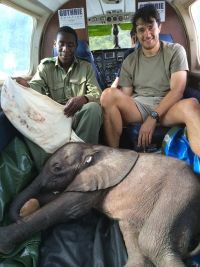 A second team comprising Wild is Life staff, Craig Danckwerts, Nadia and myself, was anxiously awaiting the arrival of the orphan at Aviation Ground Services at Harare International Airport. The little elephant was lying motionless at Keith’s feet when I peered into the stationary aircraft. With some manouvering he was lifted into a standing position and then his hot little body was lifted from the aircraft and he was bundled into the back of a Landcruiser and whisked away like a famous celebrity. Ten minutes later he was ceremoniously greeted by his new family – the staff of Wild is Life, and Roxy. He was offered a bottle, half strength at first. After a little awkwardness, he started to suck. There was hope! Little Moyo, as he came to be called, was just 56kg when he arrived at Wild is life. Considering a baby elephant generally weighs 80-100kg at birth, Moyo was very small indeed. As we drove home that night we had no idea whether Moyo would survive. At least we could rest in the knowledge that he was surrounded by an enormous amount of love and empathy. A second team comprising Wild is Life staff, Craig Danckwerts, Nadia and myself, was anxiously awaiting the arrival of the orphan at Aviation Ground Services at Harare International Airport. The little elephant was lying motionless at Keith’s feet when I peered into the stationary aircraft. With some manouvering he was lifted into a standing position and then his hot little body was lifted from the aircraft and he was bundled into the back of a Landcruiser and whisked away like a famous celebrity. Ten minutes later he was ceremoniously greeted by his new family – the staff of Wild is Life, and Roxy. He was offered a bottle, half strength at first. After a little awkwardness, he started to suck. There was hope! Little Moyo, as he came to be called, was just 56kg when he arrived at Wild is life. Considering a baby elephant generally weighs 80-100kg at birth, Moyo was very small indeed. As we drove home that night we had no idea whether Moyo would survive. At least we could rest in the knowledge that he was surrounded by an enormous amount of love and empathy.
His first weeks were fraught with finding a formula that did not give him the runs. Roxy was constantly in touch with experts from the David Sheldrick Trust, and other experienced organisations. She has been warned at every step of the way that only one out of every two orphaned elephants makes it through the nursing period of 3-4 years. The younger they are, the harder it is, especially if they do not get colostrum. The force is strong in this little baby though, and he soon settled in to his new life with all manner of companions to choose from.
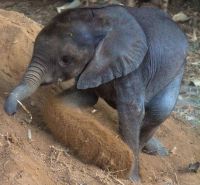 Little Moyo is now nearly 90kg. He has started to fill out and has finally got fat cheeks, which is a classic sign of a healthy elephant calf. His motor skills and trunk control are developing and are fascinating to watch, and he is now able to pick up a leaf with the “fingers” of his trunk, albeit a little clumsily. AWARE is providing veterinary care free of charge to this little elephant ambassador. Moyo’s feeding is costing a fortune, (not that anyone minds about that at all!), but his specially formulated milk replacer (gallons of it!), brown rice and 24/7 personal handlers' wages are taking their strain on his adopted Mother so she could really use your help. Please contact Roxy at roxy@wildislife.org if you can help in any way. Little Moyo is now nearly 90kg. He has started to fill out and has finally got fat cheeks, which is a classic sign of a healthy elephant calf. His motor skills and trunk control are developing and are fascinating to watch, and he is now able to pick up a leaf with the “fingers” of his trunk, albeit a little clumsily. AWARE is providing veterinary care free of charge to this little elephant ambassador. Moyo’s feeding is costing a fortune, (not that anyone minds about that at all!), but his specially formulated milk replacer (gallons of it!), brown rice and 24/7 personal handlers' wages are taking their strain on his adopted Mother so she could really use your help. Please contact Roxy at roxy@wildislife.org if you can help in any way.
Moyo will be released when he is older, but for now all involved just want to enjoy each precious moment and appreciate the privilege of getting to know him. But when the time comes, Moyo will be released to his natural home to have a family of his own; and that is as it should be! We will keep you posted on little Moyo’s progress.
Run, Walk, Ride for Rhino Fundraising Event
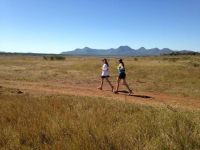 AWARE Trust and Friends of Kyle partnered with National Parks for a fun filled Run, Walk or Ride for Rhino through Mutirikwe Recreational Park (Kyle) over the Africa Day long weekend. Many sponsors such as Toyota Masvingo assisted and the event drew over 200 people into the Park with 144 of them participating in the 22km, 8km or 6km Run, Walk, Ride, many making a long weekend of it, some bringing their boats and many staying at National Parks Lodges. Those who chose to stay at the scenic campsite had to share space with the resident warthogs. One tent was retrieved after being dragged four meters through the bush by these inquisitive creatures – that’s what happens when you leave food in your tent! AWARE Trust and Friends of Kyle partnered with National Parks for a fun filled Run, Walk or Ride for Rhino through Mutirikwe Recreational Park (Kyle) over the Africa Day long weekend. Many sponsors such as Toyota Masvingo assisted and the event drew over 200 people into the Park with 144 of them participating in the 22km, 8km or 6km Run, Walk, Ride, many making a long weekend of it, some bringing their boats and many staying at National Parks Lodges. Those who chose to stay at the scenic campsite had to share space with the resident warthogs. One tent was retrieved after being dragged four meters through the bush by these inquisitive creatures – that’s what happens when you leave food in your tent!
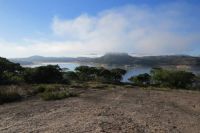 The routes were stunningly beautiful with Parks Rangers present along the way for safety sake. Participants enjoyed spotting game as they ran, including rhino, zebra, wildebeest, impala, kudu and warthog. Additional species such as buffalo, giraffe, bushbuck, baboon, vervet monkey and genet were also enjoyed by various visitors, many of whom wished they could extend their stay to savour the attractions of this well-stocked, well-patrolled Game Park, in almost 17 000 hectares of varied, undulating landscape and scenery - a beautiful combination of granite kopjes, grasslands, indigenous woodland and wetland. The routes were stunningly beautiful with Parks Rangers present along the way for safety sake. Participants enjoyed spotting game as they ran, including rhino, zebra, wildebeest, impala, kudu and warthog. Additional species such as buffalo, giraffe, bushbuck, baboon, vervet monkey and genet were also enjoyed by various visitors, many of whom wished they could extend their stay to savour the attractions of this well-stocked, well-patrolled Game Park, in almost 17 000 hectares of varied, undulating landscape and scenery - a beautiful combination of granite kopjes, grasslands, indigenous woodland and wetland.
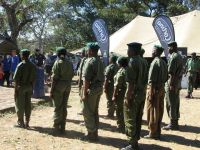 After completing their respective routes, the crowd watched the Park's Rangers parade, followed by careful inspection by the Area Manager, before AWARE presented the Rangers with new cotton caps, replacing the old felt hats which are extremely hot and offer little protection from the burning sun. Water bottles and dried foods to make up food packs for the Rangers on patrol were also donated and presented. Each group of Rangers will be issued with a food pack before setting out on patrol, making their difficult job a little easier on a full stomach. After completing their respective routes, the crowd watched the Park's Rangers parade, followed by careful inspection by the Area Manager, before AWARE presented the Rangers with new cotton caps, replacing the old felt hats which are extremely hot and offer little protection from the burning sun. Water bottles and dried foods to make up food packs for the Rangers on patrol were also donated and presented. Each group of Rangers will be issued with a food pack before setting out on patrol, making their difficult job a little easier on a full stomach.
School children from Kyle Prep and National Parks School entertained the crowd, reciting excellent poems and performing plays on the theme of protecting and conserving our rhino from the scourge of poaching and reminding us all that the future of these animals and our environment rests in the hands of the young. With much delight, the wide-eyed children all received a delicious ice-cream kindly donated.
All participants’ registration fees went to AWARE Trust to go towards rhino de-horning programs in the Park. National Parks benefitted from the Park entrance fees and accommodation with Friends of Kyle also raising funds to carry out improvements and maintenance in the Park. As hoped by the various partners in the event’s organisation, it drew attention to the plight of Zimbabwe’s rhinos as well as reminding people of what this stunning Park has to offer and the need to preserve it.
AWARE Trust wishes to continue to assist the Rangers in National Parks who carry out an extremely difficult and dangerous job and are appealing for rations, water bottles, sleeping bags and anything else that could make their lives more comfortable. If you are able to help please contact tracey@awaretrust.org.
Thanks
As always, our sincere thanks to all our supporters and sponsors – too numerous to mention here individually. Without your help AWARE would not be able to perform its vital work, so necessary to preserve and protect our wildlife and environment as a whole. Every dollar really does help and if you would like to assist please contact tracey@awaretrust.org.
|